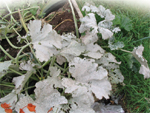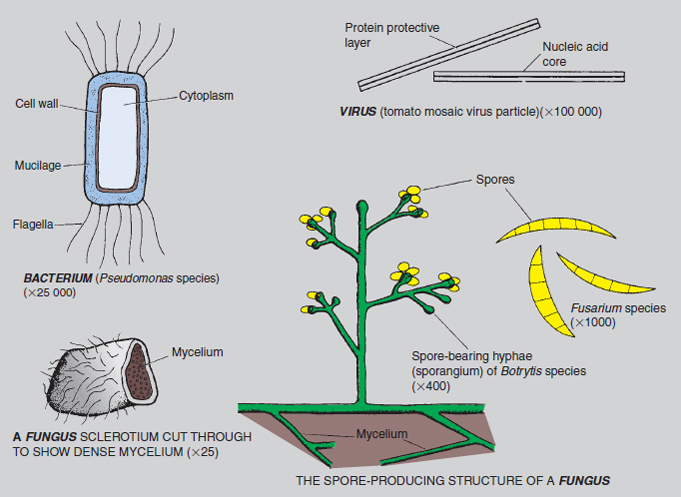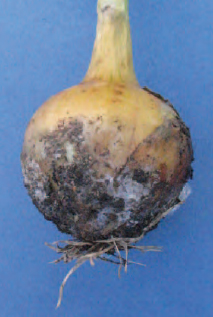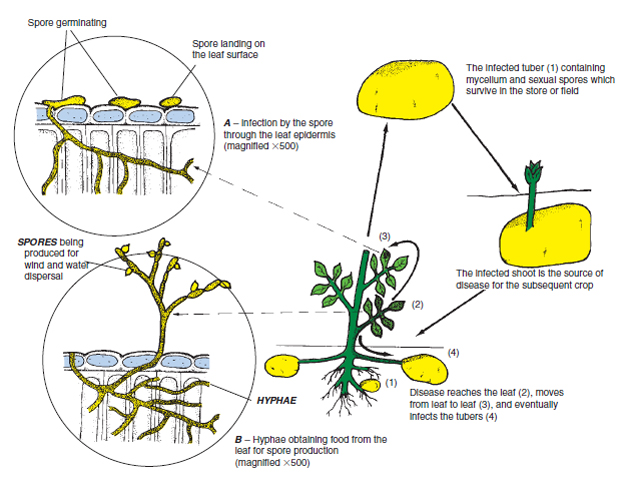Horticultural diseases and disorders
Content
Below are described some of the most important horticultural diseases caused by fungi, bacteria and viruses. Structure and biology of fungi, bacteria and virus Fungi, commonly called moulds, cause serious losses in all areas of horticulture. They are thought to have common ancestors with the filamentous algae, a group including the present-day green slime in ponds. Some details of their classification are given in Classification and naming. A fungus is composed, in most species, of microscopic strands (hyphae) which may occur together in a loose structure (mycelium), form dense resting bodies (sclerotia, see Figure 15.2) or produce complex underground rootlike strands (see rhizomorphs). The club root group of fungi is quite different, producing a jelly-like structure (plasmodium) inside the cells of the host plant. The hyphae in most fungal species are capable of producing spores. Wind-borne spores are generally very small (about 0.01 mm), not sticky and often borne by hyphae protruding above the leaf surface, e.g. grey mould, so that they catch turbulent wind currents. Water or rain-borne spores are often sticky, e.g. damping off. Minute asexual spores produced without fusion of two hyphae commonly occur in seasons favourable for disease increase, e.g. humid weather for downy mildews and dry, hot weather for powdery mildews. Sexual spores, produced after hyphal fusion, commonly develop in unfavourable conditions, e.g. a cold, damp autumn. They may be produced singly, as in the downy mildews, or in groups within a protective hyphal spore case, often observable to the naked eye, as in the powdery mildews. Different genera and species are identified by microscopic measurement of the shape and size of the spores or of the spore-bearing spore cases.
The spore of a leaf-infecting fungal parasite, after landing on the leaf in damp conditions, produces a germination tube which, being delicate and easily dried out, must enter through the cuticle or stomata within a few hours before dry, unfavourable conditions recur. Within the leaf, the hyphae grow, absorbing food until, within a period of a few weeks they produce a further crop of spores (see Figure 15.4). Leaf diseases such as potato blight often increase very rapidly when conditions are favourable. Roots may be infected by spores, e.g. in damping off; hyphae, e.g. wilt diseases; sclerotia, e.g. Sclerotinia rot; or rhizomorphs, e.g. honey fungus. Root diseases are generally less affected by short periods of unfavourable conditions and often increase at a slower, more constant rate. Phyllosphere On the surface of leaves and stems a population of micro-organisms (mainly bacteria) lives which occupy a microhabitat commonly called the phyllosphere (see also rhizosphere). These bacteria may be ‘casual’ or ‘resident’. Casual organisms such as Bacillus spp. mainly arrive from soil, roots and water, and are more common on leaves closer to the ground. These species are capable of rapid increase under favourable conditions, but then may decline. Resident organisms such as Pseudomonas spp. may be weakly parasitic on plants, but more commonly persist (often for considerable periods) without causing damage on a wide variety of plants. There is increasing evidence that phyllosphere bacteria may reduce the infection of diseases such as powdery mildews, Botrytis diseases on lettuce and onion, and turf grass diseases. Practical disease control strategies by phyllosphere organisms have not been developed, but there remains the general principle that a healthy, well-nourished plant will be more likely to have organisms on the leaf surface available to reduce fungal infection.
|
||||||||||||||||||||||||||||||||








